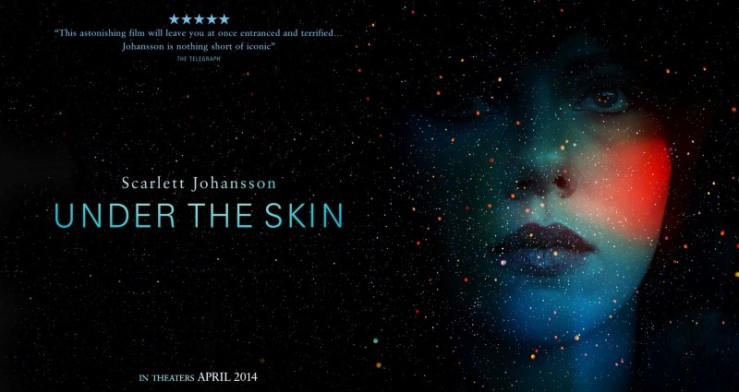
1. I hadn’t read a review of Under the Skin until after I watched it, but I had gleaned an idea of it based on taglines and posters—something like “Scarlett Johansson as a sexy alien seducing men in Scotland.”
2. That is not what the film is.
3. Under the Skin is an aesthetic experience. Now, this phrase, aesthetic experience, this phrase is extremely pretentious, and the way I’ve used it here also strikes me as pretentious, and even worse, not particularly clear. Any film could be described as an aesthetic experience. Films are, after all, simply light and sound.
4. Under the Skin is best experienced as light and sound—as aesthetic.
5. I’ve neglected to mention the film’s director, Jonathan Glazer, who directed another film I love, Sexy Beast.
6. For Under the Skin, Glazer adapted Michel Faber’s novel of the same name. I haven’t read the book, but a cursory cruise over its Wikipedia page suggests that Glazer dissolved most of the plot, keeping just the frame, or the idea of a frame for his film.
7. What I liked most about Under the Skin: The film is not really about anything. The film just happens.
8. Point 7 is a terrible description! Of course the film is about something—but its themes and motifs are overdetermined and underexplained—or not explained at all.
9. There is very little dialogue in the film—no exposition or explanation for what’s happening, let alone a conversation that might guide the audience to how to think or feel about what’s happening.
10. (Okay: This is not entirely true, but it is mostly true. There is a key conversation, if it can be called that, between Johansson’s unnamed character and a man with a deformed face).
11. The bits of dialogue that do evince often seem unscripted and random. The men Johansson’s character picks up speak in thick Scottish accents, their voices often obscured behind a din of traffic, buzz of music, or the thick glass windows of the van she drives around in.
12. (A favorite moment of auditory distortion in Under the Skin: In a domestic scene, in a kitchen, cleaning up, a man turns on his radio and just-barely tunes in a station. Deacon Blue’s “Real Gone Kid” plays through a hazy crackle. Lovely).
13. The sound mixing in the film is beautiful—waves crashing, the clip-clop of horse hooves on a high road, the wind blowing heavy through tall evergreens—these auditory cues mix in with Mica Levi’s creepy, lush score, which channels Krzysztof Komeda’s work and Bernard Herrmann’s Psycho score through Portishead and Loveless

14. Sound and light—those shots: Cinematographer Daniel Landin is the secret star of the film. Every shot is gorgeous, painterly, and if Glazer often allows a scene to linger just past an acceptable threshold, it’s because he’s in love with the film’s dark beauty.
15. (And/or: Glazer lets his shots linger so long to provoke the viewer into a kind of hypnotic discomfort).
16. The film’s early visual references to Kubrick’s 2001 are a bit on-the-nose—too on-the-nose, too expected. As the film progresses, the shots take their cues not from Kubrick’s sci-fi classic, but his most painterly film, Barry Lyndon.
17. (Under the Skin also reminded me of Upstream Color, Moon, The Man Who Fell to Earth, Tree of Life, and Morvern Callar).
18. The film is best enjoyed, as I’ve said, as an aesthetic experience, art, if that’s the word you like. I think that viewers who attempt to impose their own narrative logic on the film will attune their energy to the wrong frequency. Let the aesthetic happen.
19. (The beach sequence in this film is one of the best scenes I’ve watched in a long, long time).
20. I have completely and purposefully neglected to mention anything about the plot, because I do not think the plot, in the sense of plot-as-arrangement-of-action matters to the film. The film’s aesthetic is the plot.
21. And Under the Skin’s aesthetic is the film’s theme. This film is about seeing, hearing. Touch, taste, smell.
You can boil that down to whichever theory floats your boat—the male gaze, alienation, othering, sexual subversion, radical feminism, etc.—but I think that imposing any schema, any deep reading here, may be a way of anesthetizing the film’s aesthetic.
22. Highly recommended.

What I found so fascinating about this movie was how it dealt with space and time and our perception of it. And, in this sense, I found the plotting to be quite important.
Some riffing of my own:
We enter a van on the Scotland country roadside at night, only, once inside we see that its interior is too vast and expansive and blindingly white and, in terms of shape (or lack thereof), it seems without borders and angles and is completely incongruous with the premise of going into the space of a van as we know it. We’re sure that the van, at least on the outside, was like any other, but its interior–or, at least, how the film interprets(?) its interior–is incredible, unworldly.
We enter a rickety two-story home, only… its interior has an upstairs pool(for lack of a better descriptor) where a naked brunette woman/alien manages to walk, gracefully, on its surface, as if it were a runway… all the while allowing these young Scottish men to walk themselves, unwittingly–as if in a trance–, down into the developmentally viscous, macabre depths.
But, hold up! What kind of room and what kind of house is this?! And, if this is simply a literal exterior / figurative interior dynamic, why does this figurative interior have such intricate mechanics and why do we come to know these mechanics so well over recurrence of this episode over the span of the film’s first half?
And what about that opening sequence? It is quite allusive to Kubrick’s 2001, but such an acknowledgement, such a train of thought, gets me to conflate the impressive, realistic spaceship docking sequences of that film with its more oblique and figurative (and psychedelic) Jupiter voyage sequence. It seems to me that if Glazer was channeling Kubrick here, he did so in a remarkably weird way, suffusing those two, very distinct parts but allowing the more oblique and figurative one to preponderate.
What happens during this strange sequence is elusive of any definite and recognizable content. Nothing about what we see appears to be anthropic. And, yet, it is still evocative of a spaceship docking and, maybe, of sexual intercourse too. There are lines and shapes and mechanical motions that seem to cohere and align. There’s a hole at the end of some idealized tube and a congruently shaped miniature tube inserts itself into this hole and tunnels in.
The lushly atmospheric music during this sequence (reminiscent of Penderecki–and, thus, for me at least, by some transitive property, reminiscent of Bergman’s Persona (the stark black-and-white aesthetic of the title and credits is an obvious nod to that film too)) builds climactically and by the time this oblique tunneling sequence is concluded, we have our first shot of something recognizable, something anthropologically significant, something narratively significant: a human eye.
A macro-level assessment of this opening sequence is illuminating. It sees the start as a miniature of much of what is to come. I think it’s an apt establishment of the problematic spatial dynamics I’ve riffed about above, only its in reverse reciprocal order.
I think what I’ve gone on about above, to some degree, challenges the assertion that the plotting of Under the Skin is unimportant. Then again: perhaps it’s just that what you mean by plotting is not what I mean by plotting. I think when you consider what transpires, the order is quite significant, quite important.
LikeLike
What happens to the men after the wade into the dark fluid is the single most terrifying thing I have ever seen.
LikeLike
Yes! Like a limbo…
LikeLike
I absolutely LOVED this movie. I don’t understand why people say things like there’s no plot/it’s not really about anything. There’s a very discernible plot, unlike “Mulholland Drive,” which genuinely made no sense to me. It’s sci-fi at its best :)
LikeLike
I think the reason some folks might say that there isn’t a plot is that most audiences have come to expect that the plot of a movie will be *told* to them—and not just explicated, but also remarked upon, so that the contours of the plot are clearly defined for the audience along a certain emotional/moral spectrum. Also, most films are just a different version of the same film, so that the audience already intuits/expects certain problems, climaxes, and outcomes. This film is a different grammar (to an extent).
LikeLike
I agree. The experience for me was a bit more like reading a book, in a way, where you have to infer and fill in the gaps. Not the usual form of storytelling. I especially loved the ambiguity of the dead girl right at the beginning…was Laura her replacement? Very interesting!
LikeLike
Was her name Laura? I think I missed that (maybe she used it with one of the guys?). I got the sense that she was the dead girl’s replacement (an intuition supported by her own end at the film’s conclusion).
LikeLike
Yes, that’s her name…not mentioned in the movie but in the credits. I agree…def. her replacement!
LikeLike
Great riff.
I really liked hearing what Glazer had to say about the making of the film: http://youtu.be/hZUvIfXKVVc
LikeLike
I’d been wondering if this film was worth my time. Just as many friends have recommended it as denounced it! Now that I know what to expect, and how to best enjoy the film, I’ll definitely give it a shot. Thank you!
LikeLike
Great review. It was a visually stunning piece of art. But if you had read the book, you might be confused and disappointed. There is a different plot than in the movie. And her name is not Laura, it is Isserley, and she sacrifices herself to … what? It is not clear, which made the book more terrifying. What is “under the skin” was less about what she physically was under her skin and more about what makes a being “human.” Amazing reading experience. I would have been happier with the film if he had named it something else, and just noted that it was an homage to the book.
LikeLike
Thanks for the perspective on the book, Leslie. I think the film would have worked well under a different name, for what it’s worth.
LikeLike
This film is strange, beautiful and original. Not many movies achieve that trifecta. It also contains a consistently enrapturing performance from Johansson. But it’s far from the masterpiece some purport it to be. If you want to eschew story, character and exposition, that’s fine, but this is a work of such unrelenting opacity as to be nearly inaccessible, a worthy piece of art, and I too recommend seeing it on aesthetic grounds, but it is too intentionally withholding to attain the transcendence it endeavors to reach.
LikeLike
I think that’s a fair assessment, Sean. Also, I think the internet tends to bring a rush of praise (and overpraise) for anything that’s different and competent. I loved how withholding the film was, but my wife didn’t care for it—she said something like, “There’s nothing there for me to care about”—also a fair assessment.
LikeLike
after reading this I checked the newspaper to see where it was playing. It wasn’t. I thought “wtf”. Then I walked up to Walgreens for beer and there it was in the Redbox. Like finding 20 bucks in your pocket. Beautiful movie.
LikeLike